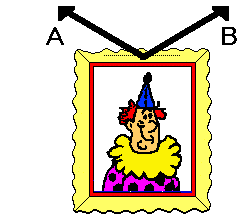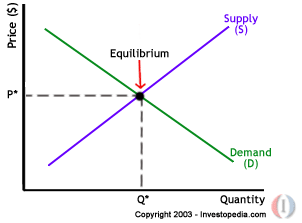Equilibrium in the World
 Equilibrium is the state in which forces are in balance.
Equilibrium is the state in which forces are in balance.Equilibrium can be in many things such as a see-saw. Equilibrium is also said to be present when in any situation and there is no outside force such as angular or linear acceleration acting against the situation, it will stay in equilibrium. This basically goes over Newton's 1st Law of motion where an object at rest will stay at rest unless acted upon by another force. Equilibrium also means that the forces in the same axis will be the same. For example in the picture with the balls on the see saw, the balls have forces on the side that are different and not equal. They instead fall when the greater force of the two sides pulls their side down.
Equilibrium in Physics
In equilibrium there are many types. There is the fulcrum where the balance is displaced and the center of balance. In cases where the torque force (Force multiplied by radius) are equal and are the same. There is two cases of equilibrium. There is one situation where both people opposite of each are the same distance from the center of balance and they have the same mass. Another scenario is where there are different masses and different radii. But the masses and radii will work out and balance. The torques of both sides must be equal where there is no force greater then another. for example in the picture, one side is the radius 16 ft and is 40 Ibs. These two factors are also affected by gravity resulting with a force of 6272 N.m (16 x 40 x 9.8). On the other side, the radius is 4 feet but 160 Ibs. with gravity added. In the end the torque force is still 6272 N.m. (4 x 160 x 9.8). This shows that the masses do not have to be the same in order to have a balanced teeter totter.
Another scenario is where there are different masses and different radii. But the masses and radii will work out and balance. The torques of both sides must be equal where there is no force greater then another. for example in the picture, one side is the radius 16 ft and is 40 Ibs. These two factors are also affected by gravity resulting with a force of 6272 N.m (16 x 40 x 9.8). On the other side, the radius is 4 feet but 160 Ibs. with gravity added. In the end the torque force is still 6272 N.m. (4 x 160 x 9.8). This shows that the masses do not have to be the same in order to have a balanced teeter totter. Types of Equilibrium in Physics
Static Equilibrium
Static equilibrium is the state in which there is no movement and the sum of the forces are zero. This is the most basic and most common.Example: a hanging picture has the support strings at static equilibrium when the forces sum affecting the picture is equal to 0 with no side greater then another
Motion Equilibrium
Motion Equilibrium is the state that there is no acceleration or change in the motion. When a ball is rolled in one direction, the ball will continue into a force acts upon it. But for then, it is in motion equilibrium.
Example: A rolling ball at a constant velocity and 0 acceleration will keep a ball in motion equilibrium until forces such as friction and gravity to slowly decelerate until it reaches static equilibrium.
Example: A rolling ball at a constant velocity and 0 acceleration will keep a ball in motion equilibrium until forces such as friction and gravity to slowly decelerate until it reaches static equilibrium.
Equilibrium in Chemistry
 In a chemical reaction, there are things called chemical equilibrium. This is when "The rate of the forward reaction is equal to the rate of reverse reaction" or in other words reactant takes the same to form as the product to form. This is represented by a two facing arrow.
In a chemical reaction, there are things called chemical equilibrium. This is when "The rate of the forward reaction is equal to the rate of reverse reaction" or in other words reactant takes the same to form as the product to form. This is represented by a two facing arrow.Equilibrium in Economics
When in economics, there is always a supply and demand. A demand fluctuates depending on a supply for the product. In a case of an iPhone or iPad, there is a large supply and a huge demand for the product creating profit. Another case of a smaller, less profitable, unimportant item, the supply may be high, but the demand may be very little. But in some cases the point of demand and supply are the same or equal resulting in economic equilibrium.
http://www.investopedia.com/terms/e/economic-equilibrium.asp

